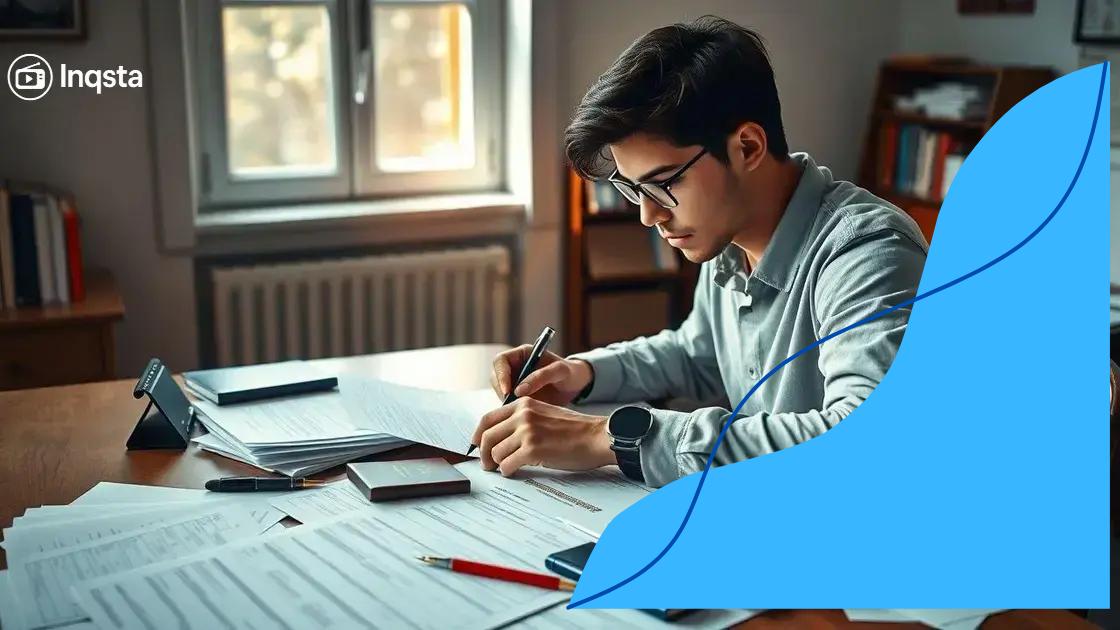U.S. Embassy warns students about visa delays

Anúncios
The U.S. Embassy warns students about visa delays, emphasizing the importance of early application, thorough document preparation, and utilizing available resources for timely assistance.
The U.S. Embassy warns students about visa delays that could impact study plans. Are you prepared for the unexpected? Let’s explore what you need to know.
Anúncios
Current visa processing times for students
Understanding the current visa processing times for students is crucial for planning your academic journey. With recent updates and changes in procedures, being informed can help you avoid unnecessary setbacks.
Average Processing Times
Visa processing times can vary significantly based on several factors. Typically, U.S. student visa applications are processed within a range of a few weeks to several months. In some cases, factors such as the volume of applications and specific country conditions may affect timing.
- Students applying for F-1 visas might experience shorter wait times in certain seasons.
- Increased application volumes can lead to delays, especially around peak enrollment periods.
- Consulates’ operational status may also impact how quickly you can get an appointment.
It’s recommended to apply early, allowing ample time for any unforeseen delays. If you’re aware of the typical processing times, you can set realistic expectations for when to start your studies.
Anúncios
Tracking Your Application
Keep in mind that you can track your application status online. This allows you to stay updated on any changes regarding your visa processing timeline. Many embassies offer tools or contact information to assist you in this process. Being proactive can ease any anxieties surrounding your visa.
As a general guideline, always check the official embassy website for the most accurate and up-to-date information concerning processing times. If you feel like your application is taking longer than expected, don’t hesitate to reach out for help.
Common reasons for visa delays
There are various common reasons for visa delays that students should be aware of. Understanding these factors can help you prepare and avoid surprises in your application process.
Incomplete Applications
One of the leading causes of delays is submitting an incomplete application. This can involve missing documents, incorrect forms, or inadequate information. It’s crucial to carefully review all requirements and provide necessary documentation to ensure your application is complete from the start.
- Make sure to check the required visa documents specific to your situation.
- Review the application checklist provided by the embassy.
- Schedule a pre-application consultation if possible.
Another common delay arises from the timing of your application. Submitting your application during peak seasons, such as before the fall semester, can lead to longer processing times.
Security Checks
Security clearances are a routine part of the visa process. If your application triggers additional security questions, this can significantly extend processing times. Such situations may arise based on your country of origin or recent travel history.
It’s essential to provide accurate and honest information in your application. Misrepresentations can lead to serious delays or even the denial of your visa.
Once your application is submitted, patience is key. You can check your application’s status online to stay updated, but be mindful that reaching out too frequently may also add to the wait time.
Tips to expedite your visa application

Applying for a visa can take time, but there are several tips to expedite your visa application. Knowing these can save you valuable months in your pursuit of education abroad.
Apply Early
Start your application process as soon as possible. The earlier you apply, the more time you have to address any potential issues that may arise. Aim to submit your application at least three months before your intended departure date.
- Check the specific timelines for your visa type.
- Consider potential delays due to high application volumes.
- Don’t wait until the last minute to gather your documents.
Scheduled appointments can fill up quickly, especially during peak seasons. Early applications give you the best chance of securing a timely appointment.
Gather Required Documents
Having all required documents ready will streamline your application. Ensure that you have the necessary forms, identification, and supporting documents prepared in advance. This reduces the likelihood of delays caused by missing paperwork.
Make a checklist of all required materials, and double-check everything before submission to avoid errors. Common documents needed include:
- Passport valid for at least six months.
- Form DS-160 confirmation page.
- SEVIS fee payment receipt.
Additionally, make sure your financial statements and acceptance letters are updated and accurate. This helps to avoid unnecessary requests for more information.
How to stay updated on visa status
Knowing how to stay updated on visa status is essential for any student navigating the complex visa application process. Staying informed can help reduce anxiety and ensure that you are ready for your education journey.
Online Tracking Tools
Many U.S. embassies and consulates offer online tracking tools for visa applications. By entering your application number and personal details, you can access real-time updates about your visa status. This feature allows you to see the current stage of your application and any pending requirements.
- Visit the official embassy website for your country.
- Look for the visa application tracking section.
- Make sure to have your application details at hand.
Using these online resources can save you from unnecessary phone calls and help you stay informed with just a few clicks.
Set Up Alerts
Many consulates provide options to receive email or SMS notifications regarding your visa status. By setting up alerts, you can get timely updates about your application without having to check manually.
This way, you will be informed immediately if there are changes to your application’s status or if additional documentation is required. Notifications can streamline your communication with the embassy and keep things on track.
In addition, reach out to your educational institution’s international office. They are often well-equipped to provide guidance on tracking your visa status and may offer helpful resources tailored for students.
Resources and support from the U.S. Embassy
Accessing resources and support from the U.S. Embassy can greatly assist students in their visa application journey. The embassy provides various tools and services designed to help you navigate the complexities of obtaining a visa.
Online Resources
The U.S. Embassy website is a vital resource for students. It offers comprehensive information about different types of visas, application processes, and necessary documentation. Make sure to explore:
- Visa application guidelines and checklists.
- Frequently asked questions specific to student visas.
- Updates on visa policies and processing times.
Regularly checking the embassy’s site can keep you informed about any changes that might affect your application.
Contacting the Embassy
If you have specific questions or concerns, reaching out to the embassy directly is encouraged. Most embassies have dedicated sections for student inquiries, and staff can provide personalized assistance. Whether it’s via email or phone, do not hesitate to ask for help if needed.
Additionally, many entry points to the embassy offer workshops and informational sessions aimed at students. These events can provide invaluable insights and tips for a successful visa application.
Lastly, consider your school’s international student office as a key support resource. They often have established relationships with the embassy and can provide guidance tailored to your specific situation.
In conclusion, being informed about the visa process is crucial for students aiming to study in the U.S. From understanding potential delays to knowing how to access embassy resources, every step counts. By following the tips provided, students can navigate the application process more smoothly and reduce stress. Remember, being proactive and seeking support can make a significant difference in securing your visa in time for your studies. Stay informed and take charge of your journey!
FAQ – Common Questions About Visa Applications for Students
What should I do if my visa application is delayed?
If your application is delayed, regularly check the embassy’s online tracking system and consider contacting them for updates.
How can I ensure my application is complete?
Carefully review the visa requirements and use a checklist to ensure you include all necessary documents with your application.
Are there resources available for international students at the embassy?
Yes, the U.S. Embassy offers several resources, including informational sessions, workshops, and dedicated support for students.
What can I do if I have specific questions about the visa process?
You can reach out directly to the U.S. Embassy or your school’s international office for personalized assistance and answers.